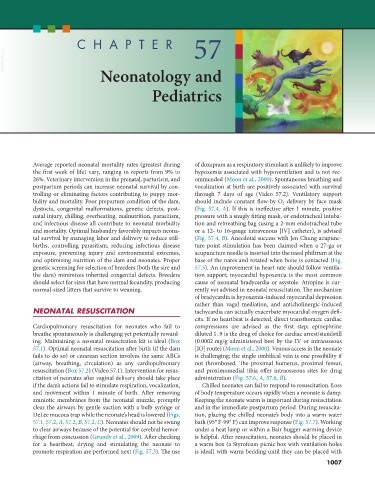Page 1035 - Small Animal Internal Medicine, 6th Edition
P. 1035
CHAPTER 57
VetBooks.ir
Neonatology and
Pediatrics
Average reported neonatal mortality rates (greatest during of doxapram as a respiratory stimulant is unlikely to improve
the first week of life) vary, ranging in reports from 9% to hypoxemia associated with hypoventilation and is not rec-
26%. Veterinary intervention in the prenatal, parturient, and ommended (Moon et al., 2000). Spontaneous breathing and
postpartum periods can increase neonatal survival by con- vocalization at birth are positively associated with survival
trolling or eliminating factors contributing to puppy mor- through 7 days of age (Video 57.2). Ventilatory support
bidity and mortality. Poor prepartum condition of the dam, should include constant flow-by O 2 delivery by face mask
dystocia, congenital malformations, genetic defects, post- (Fig. 57.4, A). If this is ineffective after 1 minute, positive
natal injury, chilling, overheating, malnutrition, parasitism, pressure with a snugly fitting mask, or endotracheal intuba-
and infectious disease all contribute to neonatal morbidity tion and rebreathing bag (using a 2-mm endotracheal tube
and mortality. Optimal husbandry favorably impacts neona- or a 12- to 16-gauge intravenous [IV] catheter), is advised
tal survival by managing labor and delivery to reduce still- (Fig. 57.4, B). Anecdotal success with Jen Chung acupunc-
births, controlling parasitism, reducing infectious disease ture point stimulation has been claimed when a 27-ga or
exposure, preventing injury and environmental extremes, acupuncture needle is inserted into the nasal philtrum at the
and optimizing nutrition of the dam and neonates. Proper base of the nares and rotated when bone is contacted (Fig.
genetic screening for selection of breeders (both the sire and 57.5). An improvement in heart rate should follow ventila-
the dam) minimizes inherited congenital defects. Breeders tion support; myocardial hypoxemia is the most common
should select for sires that have normal fecundity, producing cause of neonatal bradycardia or asystole. Atropine is cur-
normal-sized litters that survive to weaning. rently not advised in neonatal resuscitation. The mechanism
of bradycardia is hypoxemia-induced myocardial depression
rather than vagal mediation, and anticholinergic-induced
NEONATAL RESUSCITATION tachycardia can actually exacerbate myocardial oxygen defi-
cits. If no heartbeat is detected, direct transthoracic cardiac
Cardiopulmonary resuscitation for neonates who fail to compressions are advised as the first step; epinephrine
breathe spontaneously is challenging yet potentially reward- diluted 1 : 9 is the drug of choice for cardiac arrest/standstill
ing. Maintaining a neonatal resuscitation kit is ideal (Box (0.0002 mg/g administered best by the IV or intraosseous
57.1). Optimal neonatal resuscitation after birth (if the dam [IO] route) (Moon et al., 2000). Venous access in the neonate
fails to do so) or cesarean section involves the same ABCs is challenging; the single umbilical vein is one possibility if
(airway, breathing, circulation) as any cardiopulmonary not thrombosed. The proximal humerus, proximal femur,
resuscitation (Box 57.2) (Video 57.1). Intervention for resus- and proximomedial tibia offer intraosseous sites for drug
citation of neonates after vaginal delivery should take place administration (Fig. 57.6, A, 57.6, B).
if the dam’s actions fail to stimulate respiration, vocalization, Chilled neonates can fail to respond to resuscitation. Loss
and movement within 1 minute of birth. After removing of body temperature occurs rapidly when a neonate is damp.
amniotic membranes from the neonatal muzzle, promptly Keeping the neonate warm is important during resuscitation
clear the airways by gentle suction with a bulb syringe or and in the immediate postpartum period. During resuscita-
DeLee mucous trap while the neonate’s head is lowered (Figs. tion, placing the chilled neonate’s body into a warm water
57.1, 57.2, A, 57.2, B, 57.2, C). Neonates should not be swung bath (95° F-99° F) can improve response (Fig. 57.7). Working
to clear airways because of the potential for cerebral hemor- under a heat lamp or within a Bair hugger warming device
rhage from concussion (Grundy et al., 2009). After checking is helpful. After resuscitation, neonates should be placed in
for a heartbeat, drying and stimulating the neonate to a warm box (a Styrofoam picnic box with ventilation holes
promote respiration are performed next (Fig. 57.3). The use is ideal) with warm bedding until they can be placed with
1007

